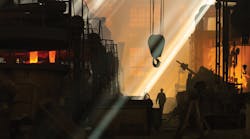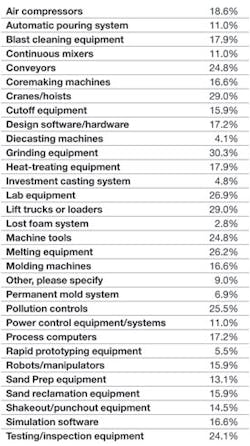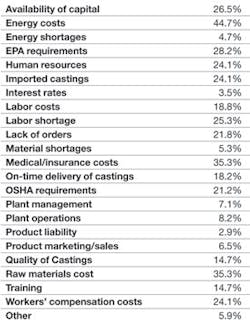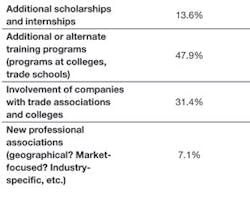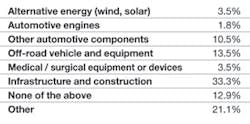Industrial capital spending continues to increase, according to a forecast published this month by IMS Research, and when the results are in for 2012 it will have risen 6.8% over the 2011 level. That study also predicts that total industrial capital spending in the Americas will pass $1 trillion by 2015: oil-and-gas is the sector drawing the most investment, more then one-third of all spending, IMS reported.
Those are the generally positive conditions that foundries and diecasters find as a new year arrives, and it's context for the general developments found in the metalcasting market. But, the closer one looks at the metalcasting market the more challenging it becomes to draw any certainty even from such encouraging trends. Confidence, such as it is, is limited.
Metalcasting is an industry meant to outlast trends, to endure both booms and busts, and metalcasting businesses need a market presence built on reliability, not availability. From the perspective of metalcasters, the 2013 Outlook is not so clear.
If anything has been learned during 2012 it's that opinions don't matter as much as results. Opinions are widely available, but finding reliable insight requires reliable sources. Each year we trust our readers' understanding of the conditions prevailing in North America's metalcasting industry, and their evaluations of its prospects.
There is a risk to conducting surveys: the results may be unwelcome, or we may not be prepared with a proper response. Worse, we may not understand the results' meaning. But there is value in the survey that FM&T conducts among readers each year: it allows us to gauge the outlook of the men and women working in North American metalcasting, to identify what problems they face in their businesses and the economy, to know what plans they're making for the coming business cycle, and to learn what they're expectations are for the year ahead.
We surveyed readers by email over a period of six weeks during September and October, identifying as nearly as possible the most senior individual at each location in our circulation. The results include responses from nearly 200 readers who represent a broad variety of foundries and diecasters: 27.4% indicate aluminum is the principal metal cast at their operations, while 19.5% are producing gray iron, 16.8% are producing steel, and 12.6% are producing ductile iron; 8.4% are producers of brass or bronze alloys, and 15.3% are producing some other alloys.
The respondents also represent a wide range plant types, from small shops with less than 20 workers to large operations with 250 or more employees. Thus, they are a reliable impression of the outlook among domestic foundries and diecasters, and an indicator of the expectations for their businesses in 2013.
More, or more of the same?
The mood among respondents certainly is not a pessimistic one. Just above 10% of the field indicate they expect to ship less in 2013 than they will ship this year – the nearest approximate for “confidence” that the survey provides. Otherwise, there is a fairly even split between those who expect shipment volumes to increase (a slight majority), and those who see no improvement (nor decline) from the current year's pace.
The expectation for increasing shipment volumes is split across all categories of metals and all sizes of operations, it should be noted, though brass/bronze foundries are decidedly more reserved in their forecast and gray iron foundries are more inclined to expect rising shipments in 2013.
A similar balance of outlook is seen in the split among foundries of different sizes: there, the smallest operations (under 20 employees) are more convinced that next year's results will be about the same as this year's; and foundries with 100-249 workers are most positive about their prospects in 2013.
To press a little further, we separated the responses between those who expect 2013 shipments to increase from 2012 levels, and those expecting a decrease. From the first, more hopeful set we learned that 46.7% of these foresee their shipments increasing by 10% or less over 2012, and 21.4% expect the increase to be 12-15%. Larger tonnage increases of 20-50% are expected by 28% of this subset of respondents, and 4% of them foresee increases of 60% or more.
Looking at those respondents who anticipate decreased tonnages next year, 22.2% of these expect the decline to be less than 10% from 2012's totals, 44.4% expect the decline to be in the range of 10-15%, and 33.3% anticipate a drop off between 20-50% from 2012 levels.
The impression drawn from these shipment forecasts is one of an increasingly atomized metalcasting industry, one shaped by general trends like regulatory standards and energy costs, but also subject to narrow influences, like growth in demand for a particular range of castings, or the success or struggles of a single large customer.
Proceed with caution
Capital expenditures are a more concrete expression of business confidence, because even though it is hard to consolidate investment totals as trending indicators, capital represents a commitment to the future of a business, a market, and the industry. As such, the investment plans of our respondents reconfirm the middling sense of optimism in metalcasting as 2013 arrives.
The types of investments in store for next year include new plants for 5.5% of our respondents, expansions to existing plants for 27.6%, and new equipment for 65.2%. It's notable that more than one-fifth of all respondents, 21.5%, have no capital expenditures planned for 2013.
More than half of our survey respondents, 56.5%, expect to maintain their 2012 capital spending totals into 2013, and 33.3% intend to increase their capital spending. Only 10.2% will cut their current spending level next year.
Among the operations where spending will increase, 16.1% of our respondents indicated the increases will be in the 2-8% range; 35.7% will have increases in the 10-15% range; 30.4% will increase investments by 20-50%; and 17.9% will have increase ranging from 50% to more than 100% — including some that will increase by many times more than 100%.
The decreases in investment will range from 5-12% for one quarter (25%) of the respondents who indicated such a direction; 20-40% for 44% of those respondents; and investment cuts of 50-100% are in store for 31% of that group.
The range of types of new equipment that will merit capital investments next year is vast, though new grinding machinery (30.3%) and handling devices (Cranes/Hoists, 29%; Lift Trucks/ Loaders, 29.%) are especially popular items. Only a bit less popular will be purchases of new Melting Equipment (26.2%) and new Pollution Controls (25.5%).
Problems remain
The great value of the annual Outlook survey is the light it sheds on the problems and opportunities of the metalcasting sector – as understood by insiders active in the market. We asked respondents to list the issues that have presented organizational problems for them during 2012, and more than two-fifths (44.7%) identified their Energy Costs; no other problem was near it in common concern for respondents. Medical/Insurance Costs (35.3%) and Raw Materials Costs (35.3%) were next in order, followed by EPA Requirements (28.2%), and then Human Resources (24.1%), Imported Castings (24.1%), and Workers' Compensation Costs (24.1%).
And in the year ahead the problems seem just as critical: 43.9% expect Energy Costs to remain atop their concerns, with Medical/Insurance Costs well behind (32.9%), and Raw Material Costs (28%) and EPA Requirements (26.2%) even further back.
Our respondents' lack of consensus continued when we sought their outlook on the direction of the overall domestic economy: 33.3% believe it will improve and 32.8% believe it will perform about the same as it has done during 2012. Another 23.6% expect the economy to decline more seriously, and 6.3% expect a considerable downturn. Just 4% of respondents believe there will be a significant improvement.
And who is to suggest that all of them may not be accurate in their outlook, according to the increasingly narrow circumstances that define success in the effort to improve and grow metalcasting businesses?
*Respondents were asked to indicate all appropriate choices: percentage totals exceed100%









